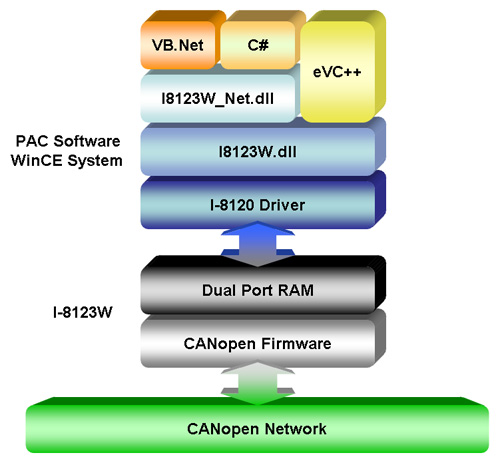I-8124W
1 Port DeviceNet Master Slot CAN (Controller Area Network) Module. 3 LED display. Has operating temperature range of -25°C ~ +75°C (-13°F ~ +167°F)
Features
The CAN (Controller Area Network) is a serial communication protocol, and efficiently supports distributed real-time control with a very high level of security. It is especially suited for network "intelligent" devices as well as sensors and actuators within a system or sub-system. In CAN networks, there is no addressing of subscribers or stations in the conventional sense, but messages are transmitted according to highest priority. The I-8124W CAN controller can represent an economic solution of DeviceNet application and be a set as a master device. It is a "Predefined Master Connection Set" and supports Group 2 only Server functions to communication with slave devices. With an independent CAN bus communication port having a 5-pin screw terminal connector, it has the ability to cover a wide range of DeviceNet applications. The I-8124W uses the new CAN controller Phillips SJA1000T and transceiver 82C250/251, which provides for bus arbitration, error detection with auto correction and re-transmission function. It can be installed on a WinPAC or ViewPAC series PAC devices. It's most popular application is in the industrial automation, building automation,vehicle, marine, and embedded control network.
- 3 indication LEDs (Error,Status,Bus LEDs)
- Programmable master MAC ID
- Programmable transfer-rate 125K, 250K, 500K
- Support maximum nodes up to 64
- Support Group 2 and UCMM functions
- The maximum Fragment number is (Input/Output) up to 64
- Support I/O Operation Mode: Poll, Bit-Strobe and Change Of State/Cyclic
- Support auto-scan slave device function
- Support on-line add device into and remove device from network
- Support auto-reconnect when the connection is broken
Software Architecture

Software CPMUtility Features
The CPMUtility utility can easily to access the I/O data of all the slave devices. The users can monitor the input data of the specific slave device and change the output data to the remote slave device with this utility.
- Auto-scan all the CANopen master devices that the CPMUtility has supported
- Auto-scan all the CANopen slave devices on the CANopen network
- Support the EDS file
- Dynamic PDO object setting easily
- Guarding Event and Heartbeat Event detection
- EMCY message receiving
- Maximum 5 SYNC message producers per CANopen master

Specifications
CAN Interface |
|
Controller |
NXP SJA1000T with 16 MHz clock |
Transceiver |
NXP 82C250 |
Channel number |
1 |
Connector |
5-pin screw terminal block (CAN_GND, CAN_L, CAN_SHLD, CAN_H, N/A) |
Baud Rate (bps) |
125 k, 250 k, 500 k |
Transmission Distance (m) |
Depend on baud rate (for example, max. 1000 m at 50 kbps ) |
Isolation |
3000 VDC for DC-to-DC, 2500 Vrms for photo-couple |
Terminator Resistor |
Switch for 120 Ω terminator resistor |
Specification |
ISO-11898-2, CAN 2.0A and CAN 2.0B |
Protocol |
DeviceNet Volumn I ver2.0, Volumn II ver2.0 |
Hardware |
|
CPU |
80186, 80 MHz or compatible |
SRAM/Flash/EEPROM |
512 KB / 512 KB / 16 KB |
NVRAM |
31 bytes (battery backup, data valid for up to 10 years) |
RTC (Real Time Clock) |
Yes |
Watchdog |
CPU built-in |
LED |
|
Round LED |
NS LED, RUN LED, MS LED |
Software |
|
Driver |
WinPAC, ViewPAC, XPAC-CE6 (The XPAC series PAC only support one I-8124W) |
Library |
For CE5: VB.Net, C#.Net, VC 2005 (with .Net Framework 2.0 or upper), and eVC++ 4.0 For CE6: VB.Net, C#.Net, VC 2008 (with .Net Framework 3.5 or upper) |
Power |
|
Power Consumption |
2 W |
Mechanism |
|
Dimensions |
31mm x 115mm x 91mm (W x L x H) |
Environment |
|
Operating Temp. |
-25°C ~ +75°C (-13°F ~ +167°F) |
Storage Temp. |
-40°C~ +80°C (-40°F ~ +176°F) |
Humidity |
10 ~ 90% RH, non-condensing |












